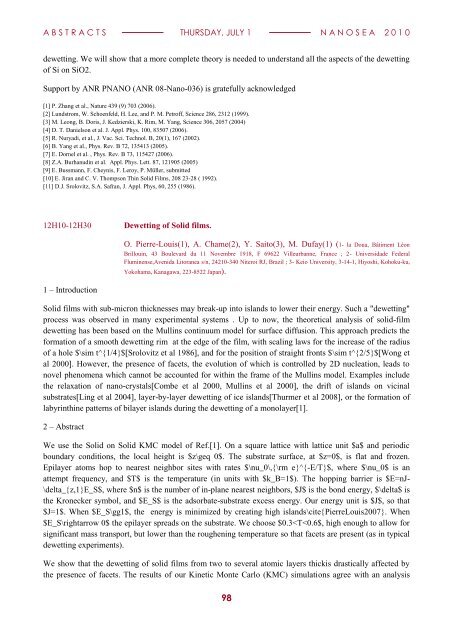book of abstracts - IM2NP
book of abstracts - IM2NP
book of abstracts - IM2NP
Create successful ePaper yourself
Turn your PDF publications into a flip-book with our unique Google optimized e-Paper software.
A B S T R A C T S THURSDAY, JULY 1 N A N O S E A 2 0 1 0<br />
dewetting. We will show that a more complete theory is needed to understand all the aspects <strong>of</strong> the dewetting<br />
<strong>of</strong> Si on SiO2.<br />
Support by ANR PNANO (ANR 08-Nano-036) is gratefully acknowledged<br />
[1] P. Zhang et al., Nature 439 (9) 703 (2006).<br />
[2] Lundstrom, W. Schoenfeld, H. Lee, and P. M. Petr<strong>of</strong>f, Science 286, 2312 (1999).<br />
[3] M. Leong, B. Doris, J. Kedzierski, K. Rim, M. Yang, Science 306, 2057 (2004)<br />
[4] D. T. Danielson et al. J. Appl. Phys. 100, 83507 (2006).<br />
[5] R. Nuryadi, et al., J. Vac. Sci. Technol. B, 20(1), 167 (2002).<br />
[6] B. Yang et al., Phys. Rev. B 72, 135413 (2005).<br />
[7] E. Dornel et al. , Phys. Rev. B 73, 115427 (2006).<br />
[8] Z.A. Burhanudin et al. Appl. Phys. Lett. 87, 121905 (2005)<br />
[9] E. Bussmann, F. Cheynis, F. Leroy, P. Müller, submitted<br />
[10] E. Jiran and C. V. Thompson Thin Solid Films, 208 23-28 ( 1992).<br />
[11] D.J. Srolovitz, S.A. Safran, J. Appl. Phys, 60, 255 (1986).<br />
12H10-12H30<br />
Dewetting <strong>of</strong> Solid films.<br />
O. Pierre-Louis(1), A. Chame(2), Y. Saito(3), M. Dufay(1) (1- la Doua, Bâtiment Léon<br />
Brillouin, 43 Boulevard du 11 Novembre 1918, F 69622 Villeurbanne, France ; 2- Universidade Federal<br />
Fluminense,Avenida Litoranea s/n, 24210-340 Niteroi RJ, Brazil ; 3- Keio University, 3-14-1, Hiyoshi, Kohoku-ku,<br />
Yokohama, Kanagawa, 223-8522 Japan).<br />
1 – Introduction<br />
Solid films with sub-micron thicknesses may break-up into islands to lower their energy. Such a "dewetting"<br />
process was observed in many experimental systems . Up to now, the theoretical analysis <strong>of</strong> solid-film<br />
dewetting has been based on the Mullins continuum model for surface diffusion. This approach predicts the<br />
formation <strong>of</strong> a smooth dewetting rim at the edge <strong>of</strong> the film, with scaling laws for the increase <strong>of</strong> the radius<br />
<strong>of</strong> a hole $\sim t^{1/4}$[Srolovitz et al 1986], and for the position <strong>of</strong> straight fronts $\sim t^{2/5}$[Wong et<br />
al 2000]. However, the presence <strong>of</strong> facets, the evolution <strong>of</strong> which is controlled by 2D nucleation, leads to<br />
novel phenomena which cannot be accounted for within the frame <strong>of</strong> the Mullins model. Examples include<br />
the relaxation <strong>of</strong> nano-crystals[Combe et al 2000, Mullins et al 2000], the drift <strong>of</strong> islands on vicinal<br />
substrates[Ling et al 2004], layer-by-layer dewetting <strong>of</strong> ice islands[Thurmer et al 2008], or the formation <strong>of</strong><br />
labyrinthine patterns <strong>of</strong> bilayer islands during the dewetting <strong>of</strong> a monolayer[1].<br />
2 – Abstract<br />
We use the Solid on Solid KMC model <strong>of</strong> Ref.[1]. On a square lattice with lattice unit $a$ and periodic<br />
boundary conditions, the local height is $z\geq 0$. The substrate surface, at $z=0$, is flat and frozen.<br />
Epilayer atoms hop to nearest neighbor sites with rates $\nu_0\,{\rm e}^{-E/T}$, where $\nu_0$ is an<br />
attempt frequency, and $T$ is the temperature (in units with $k_B=1$). The hopping barrier is $E=nJ-<br />
\delta_{z,1}E_S$, where $n$ is the number <strong>of</strong> in-plane nearest neighbors, $J$ is the bond energy, $\delta$ is<br />
the Kronecker symbol, and $E_S$ is the adsorbate-substrate excess energy. Our energy unit is $J$, so that<br />
$J=1$. When $E_S\gg1$, the energy is minimized by creating high islands\cite{PierreLouis2007}. When<br />
$E_S\rightarrow 0$ the epilayer spreads on the substrate. We choose $0.3

















